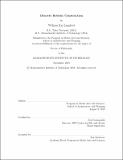Discrete robotic construction
Author(s)
Langford, William Kai.
Download1145278783-MIT.pdf (35.49Mb)
Other Contributors
Program in Media Arts and Sciences (Massachusetts Institute of Technology)
Advisor
Neil Gershenfeld.
Terms of use
Metadata
Show full item recordAbstract
Robots, which require the integration of a wide variety of mechanical and electrical functionality, are seldom built in a single process, but are instead assembled from parts created using a variety of different processes. While fabrication has advanced significantly to enable the routine fabrication of complex and precise objects from computer designs, the assembly processes used to integrate these parts are still largely manual and are notoriously difficult to automate. Recent research in digital fabrication has looked for ways to avoid assembly altogether by manufacturing integrated devices in a single process but has often struggled to integrate more than a few materials or functionalities. Instead of avoiding assembly, this work embraces it. Inspired by the universality of amino acids that are the basis of molecular biology, I demonstrate an interchangeable set of building blocks that enable the construction of a wide variety of robotic capabilities, including machines that can assemble themselves. In this thesis I introduce a discrete approach to robotic construction that enables the fabrication of structure, mechanism, actuation, circuitry, and computation in a single process through the assembly of a small set of building blocks. This work is based on discretely assembled "digital" materials, in which parts are reversibly joined with a discrete set of relative positions and orientations, allowing for global geometries to be determined from local constraints, assembly errors to be detected and corrected, heterogeneous materials to be joined, and disassembly and reuse rather than disposal. This approach simplifies the fabrication of integrated electromechanical machines and points to the possibility of building technology that is able to grow (exponential self-assembly) and self-repair. Furthermore, this approach discretizes robotic systems at a finer granularity than prior work in modular robotics, offering benefits including the flexibility to integrate heterogeneous functions, agility to rapidly construct and modify designs, and incremental extensibility in both system size and performance. These benefits help lower barriers in the rapid prototyping of electromechanical machines, make designs more reusable by providing a physical representation that facilitates design automation and abstraction, and enable machines that are more integrated than would be practical with alternative methods.
Description
This electronic version was submitted by the student author. The certified thesis is available in the Institute Archives and Special Collections. Thesis: Ph. D., Massachusetts Institute of Technology, School of Architecture and Planning, Program in Media Arts and Sciences, 2019 Cataloged from student-submitted PDF version of thesis. Includes bibliographical references (pages 127-138).
Date issued
2019Department
Program in Media Arts and Sciences (Massachusetts Institute of Technology)Publisher
Massachusetts Institute of Technology
Keywords
Program in Media Arts and Sciences